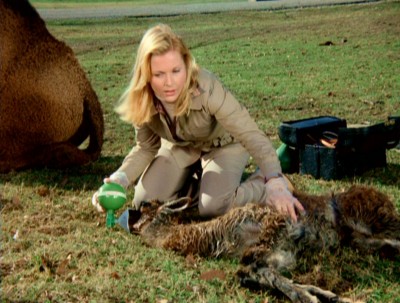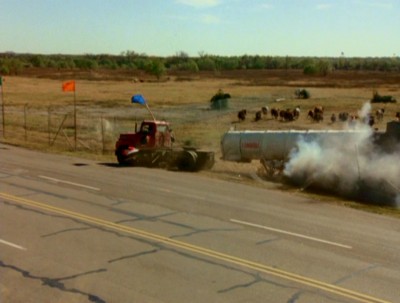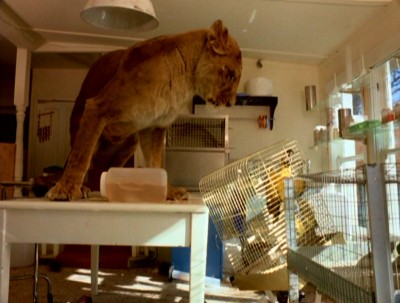Well…if everything else seems to be a disaster right now, it couldn’t hurt to watch some disaster flicks, now could it?
By Paul Mavis
Warner Bros’ Archive Collection recently released (like…10 years ago) The Beasts are On the Streets, the 1978 NBC made-for-TV disaster flick produced by Hanna-Barbera Productions, directed by James Bond helmsman Peter Hunt, and starring Carol Lynley, Dale Robinette, Billy Green Bush, Philip Michael Thomas, Casey Biggs, Burton Gilliam, Sharon Ullrick, and Anna Lee. Coming out near the tail end of the 70s disaster genre’s peak, The Beasts are On the Streets was another attempt by animator Joseph Barbera to expand into family-friendly live-action production, and taken for what it is—a disaster movie about rampaging animals breaking out of a wildlife sanctuary—it’s quite silly and fun: sort of Mutual of Omaha’s Wild Kingdom Meets The Swarm. It’s a neat, concise little family-friendly disaster outing, with no blood, lots of clean action, even a little bit of suspense, generally good acting, and plenty of cute/savage animals in motion for the small fry.
Click to order The Beasts are On the Streets at Amazon.
Your purchase helps pay the bills at this website!
At the African Wildlife Park in Texas, former “white hunter”-turned-ranger Kev Johnson (Dale Robinette) is alerted to a medical emergency by fellow ranger Rick (Casey Biggs): a camel is in breach labor (cue Charlton Heston in close-up, intoning, “Oh my god…”). Calling up nearby vet Dr. Claire McCauley (Carol Lynley) for assistance, Kev and Claire deliver the calf while trading banter about their complicated, frustrating romance: he wants her to marry him, while she doesn’t want any man to tell her or her daughter, Sandy (Michelle Walling), what to do.
Meanwhile, good ‘ol boys Jim Scudder and Al Loring (Billy Green Bush and Burton Gilliam), back from bagging a deer, almost cut off tanker trucker Carl Evans (Bill Thurman), who, later on, blasts his air horn in glee when he sees the hunters pulled over for speeding. Catching up with the trucker, Scudder pretends he’s going to shoot Carl, who, suffering from some malady that affects his vision, pulls off the highway, runs an intersection, and promptly plows his out-of-control rig along the African Wildlife Park‘s fence line. Almost immediately, hundreds of animals, including ostriches, rhinos, bears, elephants, and hungry tigers and lions (oh my), escape, menacing the cars on the roads and spreading out into the unsuspecting outlying communities.
Growing up in the 70s, no movie genre made more of a visceral, lasting impact on me (at least at the theaters) than disaster movies. Not many Westerns, except for John Wayne‘s yearly outings, were playing at the time, and spy movies, with the exception of Bond, were rather drab for a long time there (try getting excited over a double feature of The Mackintosh Man and The Tamarind Seed some Saturday night). Sci-fi adventures were extremely hit and miss until “you know what” premiered in the summer of 1977 (sure Zardoz is fun to watch now…but try it as an 8-year-old). Thrillers or mysteries were close seconds…if they were fast and violent (something like The Seven-Ups would have us coming back the next day…before we fell asleep during The Drowning Pool).
RELATED | More 1970s TV reviews
Disaster movies, though, were never-fail, and that was important if you made that .50 cents mowing a lawn or washing cars or doing your brothers’ chores because they lacked the self-discipline and strength of character to do them themselves before they went out on their various drug binges paid for by selling your G.I. Joe action figures and comic book collections. I didn’t see one I didn’t like during that long-gone “golden age,” even if I knew it was junk (you think I cared that they just threw a Hot Wheels car into a tub of dirty water for Damnation Alley‘s big finale?). The excesses and clichéd conventions of the genre weren’t drawbacks, but highly-anticipated treats. Whether they “worked” (Jennifer Jones’ and Fred Astaire’s completely incongruous—and surprisingly touching—romance in The Towering Inferno) or not (Erik Estrada saying, “I like my coffee sweet, mommy,” while sexually harassing Christopher Norris in Airport 1975) was completely beside the point.
The brilliant examples of the genre (I passed out cold when my old man said he was taking me to a drive-in double-feature of The Towering Inferno and The Poseidon Adventure) and the offal (I sat completely alone in a 900+ seat theater, loving every single minute of The Swarm), were as like one. If you were a kid and felt the actual theatre structure begin to crumble when that first tremor hit in Earthquake, or you saw George Kennedy make love to Bibi Andersson on a bear rug in The Concorde…Airport ’79, well…you don’t forget those sorts of things. Not ever.
And the same thing went for small-scale TV disasters, too. If you were a fan of the genre back then, you probably already sensed the disaster fad would fade sooner rather than later, when numerous low-budget network knock-offs starting popping up with regularity. That realization, however, didn’t stop you from watching every single one of them, and remembering most. Sure, the gold standard of small-screen disaster came from, not surprisingly, the producer of gold standard big-screen disaster, Irwin Allen, with offerings like Fire! and Flood! and Cave-In! (yes, the exclamation points did help make them more exciting). However, if you saw that even someone as unlikely as cartoon giant Hanna-Barbera was getting in on the act, you tuned in.
I saw The Beasts are On the Streets when it premiered back in May of 1978 (inbetween Gray Lady Down‘s debut in March, and right before The Swarm‘s notoriously ballyhooed premiere in July), but details of its storyline were fuzzy, prior to watching this disc for the first time. All I remember is Blazing Saddles‘s Burton Gilliam cackling away in a truck, and the image of Carol Lynley brushing that impossibly blond hair away from her serene, impassive face (I had a huge thing for her back then, from movies like The Poseidon Adventure—those hot pants—and suspense offerings like Bunny Lake is Missing and B-horror classic, The Shuttered Room). Other than that, The Beasts are On the Streets was a blur to me.
So, I was pleasantly surprised at how much I enjoyed catching The Beasts are On the Streets again. Written by Laurence Heath (a true headcase—look him up—whom nonetheless wrote all kinds of good and bad television, include trash classic, Jacqueline Susann’s Valley of the Dolls), The Beasts are On the Streets‘s premise is rather ingenuous…even if I’m not too sure it would work out that way (wouldn’t those animals be spooked to the other side of the park by a huge explosion and burning tanker truck, instead of immediately piling out of the blown hole in the fence?). Necessarily held back from delivering even PG-rated thrills because of the restrictions of ’70s TV and because of Hanna-Barbera’s commitment to family-friendly fare, the worst you’re going to see here is some tame tigers playfully wrestling with their trainers…and that’s about it.
However, director Peter Hunt, a consummate action editor/director who helmed what is still the best movie in the Bond series (the epic, tragic On Her Majesty’s Secret Service, with my favorite Bond, George Lazenby), keeps things bouncing along despite the budget, constantly cross-cutting between several sequences to jack up the suspense, with all of them cleanly designed and executed. You have to give credit to the writer here, too—The Beasts are On the Streets throws in everything, from exploding tanker trucks to bear attacks, to a little girl in her home menaced by a lioness, to said same lioness menacing a heart surgeon during an emergency open heart operation, to ostrich attacks via VW Bug, to a last-minute brush fire.
As for the acting and the “disaster victim backstories,” Lynley and Robinette won’t surprise you with any of their pro forma bantering; however, they have an agreeable, easy chemistry together that doesn’t hurt, while more importantly, they don’t insult us by taking any of this too seriously (hamming up their scenes would only emphasize the script’s bare spots). Familiar face Billy Green Bush, though, walks away with the acting honors here, helping to get across a reasonably intriguing subplot of a controlling, headstrong father who doesn’t listen when he should, and who thinks his shy, hunting-hating son (Jeff Bongfeldt) needs to become a man by foolishly joining him in a nighttime lion shoot (the best acting here? John Stephenson dubbing in his Flintstones “Mr. Slate” voice for the helicopter pilot).
As for the action scenes, sure some of The Beasts are On the Streets‘s stuff is a little silly (nobody noticed that lioness just waltzing into an operating room?). But remember: that’s what makes the disaster genre so much fun. So if you’re into the black panther trying to eat the people in that one car, only to find yourself cracking up when a bear walks by on its hind legs looking for a ball to balance on its nose, it’s okay. It’s that kind of movie.
Read more of Paul’s TV reviews here. Read Paul’s film reviews at our sister website, Movies & Drinks.














Love that scene of the animals rampaging on the highway. I had most of those Matchbox cars in my collection!
LikeLiked by 1 person